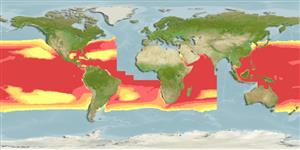Teleostei (teleosts) >
Carangiformes (Jacks) >
Echeneidae (Remoras)
Etymology: Phtheirichthys: Greek, ptheiros, a fish that parasites other + Greek, ichthys = fish (Ref. 45335).
Environment: milieu / climate zone / depth range / distribution range
Ecology
Marine; pelagic-oceanic; oceanodromous (Ref. 51243); depth range 0 - 5 m (Ref. 86942). Subtropical
Worldwide in tropical and subtropical waters. Western Atlantic: South Carolina, USA and northern Gulf of Mexico to northern South America (Ref. 7251). Western Central Pacific: Guam (Ref. 35720).
Size / Weight / Age
Maturity: Lm ? range ? - ? cm
Max length : 76.0 cm TL male/unsexed; (Ref. 2850)
Rare (Ref. 4389), oceanic species. Most often found attached to barracudas but also to other fishes and sea turtles. Clings to body of host and also found inside gill chambers.
Life cycle and mating behavior
Maturity | Reproduction | Spawning | Eggs | Fecundity | Larvae
Heemstra, P.C., 1986. Echeneidae. p. 662-664. In M.M. Smith and P.C. Heemstra (eds.) Smiths' sea fishes. Springer-Verlag, Berlin. (Ref. 4389)
IUCN Red List Status (Ref. 130435: Version 2024-1)
Threat to humans
Harmless
Human uses
Tools
Special reports
Download XML
Internet sources
Estimates based on models
Preferred temperature (Ref.
123201): 20.9 - 29.1, mean 26.9 °C (based on 39944 cells).
Phylogenetic diversity index (Ref.
82804): PD
50 = 1.0039 [Uniqueness, from 0.5 = low to 2.0 = high].
Bayesian length-weight: a=0.00257 (0.00110 - 0.00600), b=3.17 (2.96 - 3.38), in cm total length, based on LWR estimates for this (Sub)family-body shape (Ref.
93245).
Trophic level (Ref.
69278): 3.6 ±0.5 se; based on size and trophs of closest relatives
Resilience (Ref.
120179): Medium, minimum population doubling time 1.4 - 4.4 years (Assuming Fec < 10,000).
Fishing Vulnerability (Ref.
59153): Moderate to high vulnerability (50 of 100).
